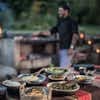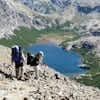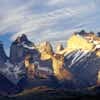.jpg?auto=format,enhance,compress&fit=crop&crop=entropy,faces,focalpoint&w=1880&h=740&q=30)
Preparing for Patagonia
For many, Patagonia is the adventure of a lifetime, so it's important to make sure you are fully prepared for your time exploring the region. Discover everything you need to know with this guide, from staying healthy and physically preparing to keeping connected whilst you travel.
Staying healthy
Vaccinations
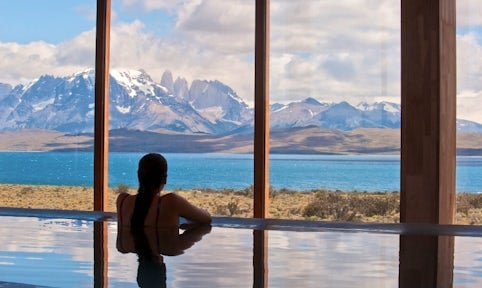
There are no compulsory vaccinations for Chile or Argentina at the current time (including Covid-19) but requirements are subject to change, so it is best to check with your local doctor. For more information check the Centers for Disease Control and Prevention website.
Make sure your immunisation is up to date for:
- Tetanus
- Hepatitis A
- Diphtheria - re-vaccination recommended every 10 years
- Hepatitis B - higher risk for long stays and frequent travel
- Typhoid - for travellers who may eat or drink outside major restaurants and hotels
- Rabies - the risk of being bitten or scratched by a rabid animal is rare however it is recommended that you are vaccinated against rabies if you will be staying for an extended period of time if you will be in close contact with animals or cycling. If you do get bitten or scratched by any animal during your time in Chile or Argentina it is recommended that you seek medical advice as soon as possible.
- Yellow fever - vaccination recommended for all travellers to Iguazú Falls who are 9 months old or over. You will need to be vaccinated at least 10 days before you travel to allow enough time for the vaccine to work.
You can find out more with our guides on Getting to Chilean Patagonia and Getting to Argentinian Patagonia.
Medical assistance in Patagonia
Both Chile and Argentina have public health care, which is free of charge to foreign nationals. The quality and efficiency of such services are highly variable and are not to be relied upon. Comprehensive health insurance is highly recommended for any traveller visiting Patagonia.
Fortunately, all major cities in Patagonia have a good level of private medical assistance, compared to western standards, to treat most emergency situations that you may encounter. Not all clinics will speak a good level of English, so an interpreter may be required, and if complex medical situations arise, you may be referred back to the capital city for continued analysis or care.

Ascending Lanín Volcano
Physical preparation
You are unlikely to need to prepare for the altitude of your trip - the Andes have lost most of their altitude upon reaching Patagonia. The highest peak in Patagonia sits at just 4,058m above sea level (compared to Aconcagua's 6,996m further north), so there is no mountain sickness to worry about.
In terms of general fitness, we'd just recommend making sure you are fit enough for the trip you have booked and are prepared for the intensity and number of hours per day of physical activity. It’s better to be well prepared physically than risk being overly exerted on the trails and it affecting your enjoyment of the trip.
If you have any injuries or health problems then please be sure to check with your doctor before travelling.
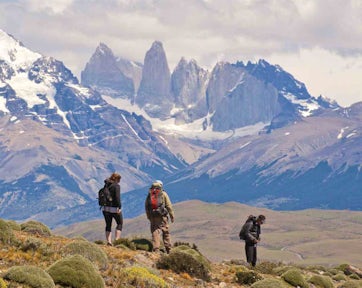
Base of the Towers

Swoop says
It always pays off to train before a trek; you will simply enjoy it more. If you'll be carrying a pack try to do some training hikes with one beforehand so you are accustomed to the weight.
Food allergies and intolerances

Patagonia is a vast region with great swathes of remote wilderness. When you are away from the larger towns or cities, please bear in mind that it is much harder for guides, refugios or other parties to cater to food and drink allergies or intolerances in the wild and with limited resources.
If you have a serious food allergy, you should approach your time in Patagonia with caution, especially in remote eating scenarios. Whilst our partners on the ground will do their best to cater to your needs, they will not be used to being as fastidious and careful as you may need to be on a day-to-day basis.
It is also worth mentioning that celiacs might not always have many options, especially outside of the larger cities. If you are concerned about your time in hotels, towns or cities, or on board an adventure cruise, we would suggest speaking with the hotel or ship manager and getting a message to the head chef or head waiter as early on in the experience as possible.
Drinking water in Patagonia
When in Patagonia, most towns and cities will provide drinking water from the tap/faucet. The water may have a slightly chlorinated taste, and some travellers may want to purchase bottled water at times.
When hiking on trails, you can nearly always fill water bottles from the streams and therefore not need to purchase and carry a lot of water. We would always recommend packing a large reusable water bottle so that you can take what you require for your excursion, instead of using lots of smaller plastic bottles.
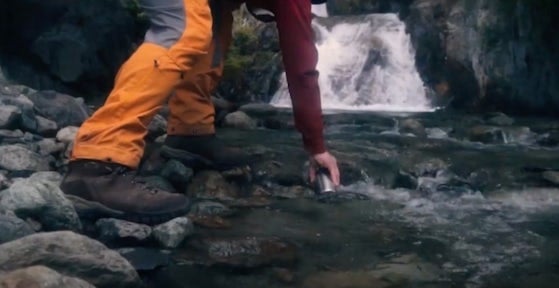
Time zones
Argentina
Argentina uses the UTC-3 time zone, called Argentina Time (ART). It determines whether to observe daylight saving time on a year by year basis, although it has not since 2009.
- UK: 4 hours ahead (08:00 Argentina = 12:00 UK)
- USA: 1 hour behind (08:00 Argentina = 07:00 USA)
- Australia: 14 hours ahead (08:00 Argentina = 22:00 Australia)
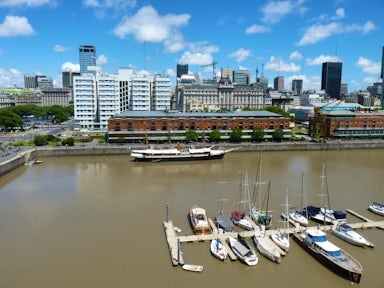
Puerto Madero, Buenos Aires
Chile
Chile also uses the UTC-3 time zone and observes daylight saving time. Easter Island uses the UTC-5 time zone.
- UK: 4 hours ahead (08:00 Chile = 12:00 UK)
- USA: 1 hour behind (08:00 Chile = 07:00 USA)
- Australia: 14 hours ahead (08:00 Chile = 22:00 Australia)
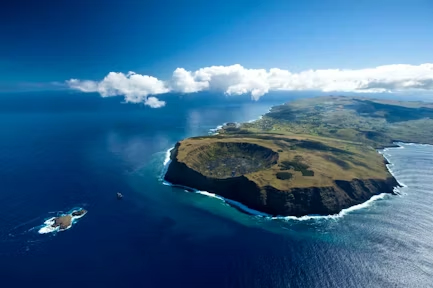
Easter Island from the air
Keeping connected
In most of both Chilean and Argentine Patagonia, you will be able to get cell coverage in and around even the most remote settlements. Once you are truly in the wilderness, however, you will be out of cell coverage. This is the case for most multi-day treks you might take in the region, and for any cruises that you embark on. Please plan accordingly for this eventuality, and don’t expect the connection to be very good when in remote towns/villages.
SIM cards are easily purchased in the larger cities, and the best companies for coverage in Patagonia tend to be ‘Movistar’ (in Argentina) and ‘Entel’ (in Chile). 5G networks are not to be expected in Patagonia.
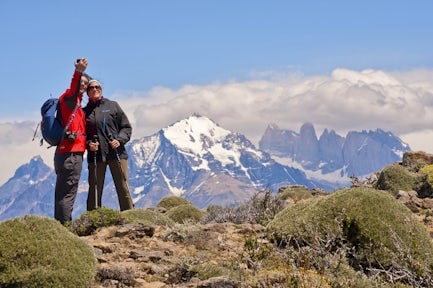

Swoop says
Please note that the two round pins that fit a Chilean plug socket are generally slightly slimmer than some European plugs. These are generally known as Type C and are approximately 4mm in diameter versus the European type F, which are 4.8mm. Factor this in when choosing your plug adaptor!
Other considerations
It's worth learning a bit of the local language before you travel. It can make it easier to communicate when you are in more remote areas and allow you to feel more embedded in your Patagonia experience.
Try not to take any disposable plastic. Use reusable carrier bags or take Tupperware boxes to pack your lunch where possible. Read more tips on packing consciously.
Consider taking all of your rubbish to the nearest largest town for recycling, or better still, back to the capital city where recycling options are more prominent. Sadly, a lot of waste in Patagonia still goes to landfill.

Gaucho in Aysen
What our customers think of Preparing for Patagonia
Because getting to Patagonia from the US usually requires multiple connections and airlines, the probability of delayed luggage is increased. I was so glad we had essential toiletries, one change of clothes, a warm jacket, and rain gear in a small carry on, so we were able to still enjoy our time until the bags eventually caught up with us. Read the full review
Travelled: April 2025
Lisa Jibson - USA
The challenges I did not anticipate were carrying a heavy backpack for 5 days and not having a resting day in between hikes. I felt I was among the oldest trekkers (57 y/o) and although I am in good shape and have accomplished strenuous hikes in the past, the trek was more challenging than anticipated. I would advice others to take more days doing the trek to include resting days. Read the full review
Travelled: December 2024
Sandra Muvdi - USA
We were prepared, with credit to Swoop for making sure that was the case. Read the full review
Travelled: November 2024
Mary Acker - USA
Take hiking poles (we had these and they are definitely worth while!) Read the full review
Travelled: November 2024
Blake Allen Aspen - Canada
Make sure you prepare by hiking long distances before your trek. Warm clothes, especially for rain (rain jacket and rain pants) are key, as are hiking poles. Read the full review
Travelled: November 2024
Sondra Panico - USA
We followed the Swoop advice for clothing preparation which was very sound. Patagonia is a big place and covers some very different climates and costs. Plenty of research is the key. Read the full review
Travelled: November 2024
Robert Charles West - Australia
We found your team to be very attentive and proactive in helping with our holiday. The webinar you offered to help prepare was also excellent. Read the full review
Travelled: November 2024
Anthony Bird - Canada
I underestimated how much cash (US and Pesos) I would need for various tipping because I didn't want to carry too much, but it is wise to think through all of the stages of the trip as to where tipping might come up so you bring enough. Read the full review
Travelled: November 2024
Anthony Bird - Canada
Do be prepared for all types of weather! We only had very little rain but during the treks I wore between 1 to 5 layers. As I got hot layers came off but then went back on if I got cold or it rained. The wind at times was much stronger than I anticipated. Read the full review
Travelled: November 2024
Vivien Parker - UK
Be prepared for all types of weather. And be prepared for it being a huge place and that it takes a long, long time to get there and get around there. Be prepared to be amazed. Read the full review
Travelled: November 2024
Marianne Michelle Dorion - UK
Prepare for the physical demands of the hikes and embrace serendipity as it happens. You will experience more than you could possibly have imagined. Read the full review
Travelled: November 2024
Steve Casey - USA
The advice given by Swoop is spot on. Read the full review
Travelled: October 2024
Judith Neal - UK
The Swoop Adventure Planner and Travel Guides are top notch. Nearly any question I had could be answered in great detail. I really made use of these resources and it helped me feel so ready and prepared to make this the incredible experience I hoped it would be. And it was! Read the full review
Travelled: October 2024
Katherine Scofield - USA
If you like being outside, Patagonia is for you! Despite the unpredictable and windy weather, there's something quite magical about it. Take the advice on the layers! Read the full review
Travelled: September 2024
Laura Pearce - UK
Bring all the recommended clothing items. Changes every 5 minutes. Read the full review
Travelled: September 2024
Jill Konkol - USA
Definitely bring hiking poles Expect lots of weather changes-it was very cold with intermittent high winds and rain in February. I was glad to have a down layer in my hiking pack not just at the camp, and rain gear is key. Read the full review
Travelled: February 2024
Eve Leeman - USA
Utilize the resources that Swoop provides, because I found they were extremely helpful in the planning in preparation for the trip. I especially utilize the what to pack videos and they helped tremendously. Read the full review
Travelled: February 2024
David Smith - USA
You all do a great job of helping people plan/pack/prepare well! I had everything I needed but not too much extra at all. Read the full review
Travelled: January 2024
Jodi Callison - USA
Be in shape! The terrain is beautiful but challenging. Going against the wind is to be expected and you should have some practice. Read the full review
Travelled: January 2024
Carol Mathews - USA
Read what you’re sent from Swoop to help prepare. Go in with the knowledge you are going to challenge yourself. Read the full review
Travelled: January 2024
Tina Ritschard - USA
Trekking poles are extremely helpful. Bringing a pair of recovery sandals is a good idea too. Read the full review
Travelled: December 2023
Wang Xiang - USA
All the advice Swoop gave regarding layers, packing, etc was perfect! I felt I had the right amount/type of clothes. The only thing I would maybe change is our family thought we were better than needing the hiking poles. We found that EVERYONE needs hiking poles for the Laguna de Los Tres hike & Puesto Cagliero hike (haha). Maybe a stronger recommendation to get the poles?? but other than that it was perfect! Read the full review
Travelled: December 2023
Elizabeth Mayfield - USA
The Swoop team was amazing preparing for our trip. We have recommended you to many people already. We are grateful for your knowledge and expertise in putting together our amazing itinerary. I just put some things that will hopefully help you make it even more amazing for travelers in the future. Thank you all that were apart of it. Our trip was Epic. We will be taking about it for a long time. Read the full review
Travelled: December 2023
Desiree Kelly - USA
Any of my advice would be specific to my physical preparation for the trip/hikes relative to where they are from a physical fitness standpoint. As a "desk jockey" in corporate America, I wished I had amped up my workouts leading up to the trip even more but I still feel pretty good about how I did. Read the full review
Travelled: December 2023
Lori Bello - USA
I cannot praise Swoop highly enough. Everyone planning a trip to Patagonia should consider their services!
Travelled: November 2023
Jonathan Earl - UK
Bring EVERYTHING on the packing list and make sure to reset your expectations for how strenuous the hiking is. It’s hard! But worth it. Read the full review
Travelled: October 2023
Jacob Baron - USA
Patagonia is incredibly beautiful and you can't go wrong with any of the national parks. Just be prepared for all four seasons in one day, as we experiences crazy weather changes within minutes. Read the full review
Travelled: October 2023
Angela Wozniak - Australia
How prepared and excited for Patagonia did you feel? Stoked! Pre-travel call answered the last couple of questions I had about the trip. Really appreciated the tipping info Swoop recommended. Read the full review
Travelled: October 2023
Tammy Walters - USA
We had never used poles before, our guide lent us one and it transformed our walking experience. Just one helped the knees enormously especially in tricky areas. Read the full review
Travelled: March 2023
Chris Gibbs - UK
Take good shoes that are waterproof!! Don’t take trainers but good hiking boots! Same with raining clothes - invest in good quality. Pack a thin rope for hanging up wet clothes between the bunk beds. Pack some warm clothes for the (lunch) breaks between hiking and for the evening and make sure they keep dry. Use different sizes of waste bags to pack your belongings in order to keep them dry in the backpack (no need to invest in des bags as they are quite expensive) Read the full review
Travelled: March 2023
Paulina Navas - Austria
I felt VERY excited and as prepared as one could be for most of our trip thanks to the information that Swoop provided. Our trip would not have gone that smoothly without Swoop getting us prepared first! Read the full review
Travelled: March 2023
Zeah Venitelli - USA
Take plenty of socks and train before you head out. Read the full review
Travelled: March 2023
Barry Davis - USA
Important to ensure you have the right gear with you as the weather really can change very quickly. Allow for time between flying in and going to your first adventure as delays can happen in travel. We took a cople of nights in Santiago and a night in Pueto Natales which was really worth while as it allowed for really enjoying the environment without being really jet lagged and not appreciating the magnificence of it. Read the full review
Travelled: February 2023
Catherine Drury - USA
I felt very prepared for the trip, both from the information provided by Swoop and from my own research and preparation. Read the full review
Travelled: February 2023
David Alexander - USA
I felt that we were prepared based on all of the information given to us by Swoop. Read the full review
Travelled: February 2023
Kassandra Kayal - USA
Even though it was summer time in Argentina and we were advised the weather is mild....I would advise all to bring lots of layers as "Patagonia" weather is very unpredictable and was very cold during the treks due to wind and hail at times. Read the full review
Travelled: February 2023
Rina Patel - USA
I feel like we were very prepared for the experience, culture and currency of Argentina and Chile as a result of the help and education we received from Swoop staff.
Travelled: February 2023
Ken Kerr - USA
We were very prepared, but believe it when people say to bring a lot of layers and plan for all types of weather. It went from 40 degrees to 70 degrees very quickly and then all the sudden it rained. The wind is very high at times and a wind protection clothing system is best! Be sure to bring rain coat and pants as you never know when a storm will blow over the mountains. Be sure to do some cardio training as the hikes are long and you will thank yourself after the 3 day tour. Read the full review
Travelled: February 2023
Brett floyd - USA
emphasize to future travelers in Chile how important the PDI form that you get from customs is and that you need to keep it with you. My friend left it in her bag in Puerto Natales and she had troubles with check-in at every Refugio. None of us had any idea what that form was for but fortunately the rest of us had kept them in our passports. Read the full review
Travelled: January 2023
Amanda Ortega - Italy
Planned to be wowed by the overwhelmingly gorgeous mountains. Take whatever supportive supplies in case you have even mild injury. Pack light. Read the full review
Travelled: January 2023
Lori Zukerman - USA
We felt very prepared and very psyched. We didn’t know what to expect but Swoop did a great job getting us ready. Read the full review
Travelled: January 2023
Monica O'Connor - USA
Read the packing list carefully and bring appropriate clothing for dressing in layers. Good hiking boots are mandatory. Read the full review
Travelled: January 2023
Ira Fishman - USA
Use trekking poles!!! They are so useful for saving your legs on multi-day hikes. Have very comfortable hiking boots that are waterproof! Read the full review
Travelled: January 2023
Kelly Rehrauer - USA
Be ready for the long transfers--Patagonia is a vast area. Read the full review
Travelled: January 2023
Barbara Lesher - USA
Pack light clothes in summer to avoid attracting the coliguachos! Read the full review
Travelled: December 2022
Katia Fischer - USA
A stretchable rain coat was the very best item we all brought. It was lightweight but provided great wind and rain protection. Also bring a puffy jacket and a base layer. And bring a buff. But also bring a couple T-shirts! Climate change is real! Read the full review
Travelled: December 2022
Kathryn Lowell - USA
The weather can change every 15 minutes and provides uniqueness all the time. Read the full review
Travelled: December 2022
Spencer Hess - USA
Bring layers - the weather changes throughout the day. Bring short sleeves, long sleeves, fleece, wind/water layers, all of it. Also bring two pair of good shoes - it helps to give your feet a change of pace after hiking so many miles each day. Read the full review
Travelled: December 2022
Spencer Hess - USA
Read the Swoop guides. Layering up is great advice as weather changes frequently. Need sunscreen and a rain jacket. Read the full review
Travelled: December 2022
Hugh Mulcahy - Ireland
Following the packing guide (video) and you’ll be set! Remember to print out your travel guide as it has lots of important information (including how to tip!) We fortunately had our guide printed and shared it with others on our trip. Bring cash! Read the full review
Travelled: December 2022
Kathryn Trumbo - USA
For the Argentinean side, take lots of cash (Euros and USD were readily accepted at the money changers) as the official rate is much lower than the blue rate. Check what happens with credit cards as there was a rumour just before I left that the government allowed credit cards to use the blue rate rather than the official rate. For USD a much better rate was given for $US100 bills than for other notes. The smaller bills were accepted in some other businesses sometimes with better rates than the money changers. The accommodation accepted USD. There was no differentiation in exchange rate for the different Euro notes. Read the full review
Travelled: December 2022
Ettrick Sonntag - Belgium
Pack layers. Come with an open mind, be ready for anything to happen and learn to adapt to it. Not everything will go to plan each day. That is part of the adventure. Read the full review
Travelled: December 2022
Nick Pilger - USA
As a “senior”, my trekking was limited. However, the van tours drove us to all the major sites. The guides were friendly and knowledgeable. Read the full review
Travelled: December 2022
Peter Schmid - USA
Planning the trip with Swoop took the questions and stress out of planning a trip in an unfamiliar country/area - the information provided online and through emails and calls prepared us for the trip. I shared what we were looking for from the trip and they were quick to share their ideas from their own experiences. Read the full review
Travelled: December 2022
Jaime Toigo - USA
Plan for the unexpected, plan for wind, rain, snow, and sleet. Plan for cloud coverage and poor visibly. Plan extra time, as the elements will be against you. Read the full review
Travelled: November 2022
Nick Jakubowski - USA
Both Chile and Argentina are far more developed than we anticipated. We also wish that we had taken the time to learn a bit more Spanish before the holiday. Read the full review
Travelled: November 2022
Mark Harris - UK
Patagonia is a great place to go, but be prepared for all weather conditions. Read the full review
Travelled: November 2022
George Bunting - USA
Clothing – everyone tells you this, but yes, have lots of good layers and prepare for very windy weather. I would take layers on and off four or five times during one hike as conditions changed. Bring a 'just in case' small medicine kit because once you are up on the W Trek there is nowhere to go. I was thankful that I brought Ibuprofen with me and cough drops. Apparently cough drops aren't really a thing in Chile? Read the full review
Travelled: October 2022
Melinda Landchild - USA
Spring weather is very erratic. Hiking poles are very helpful. Good rain gear and waterproof hiking boots are essential. Prepare to be cold and damp in the spring. If you plan to hike, prepare physically before the journey. Read the full review
Travelled: October 2022
Brad Pontius - USA
Expect to be without cell service for extended periods of time. We planned for this inconvenience by carrying a miniGarmin inReach that has limited texting functionality. Distances are long so be prepared for the time in the vans. Read the full review
Travelled: April 2022
Suzanne Williams - USA
Plan ahead, travel light, bring slippers :) Read the full review
Travelled: March 2022
Karan Bhalla - USA
Be prepared for long hikes. Bring layers of clothing which you may have to change into and out of a number of times in a single day. Not all creature comforts may be available including fast internet but we found that to be a good thing. Don't forget the sunglasses and the SPF 50, even on cold days. Read the full review
Travelled: November 2021
Sean Johnston - USA

